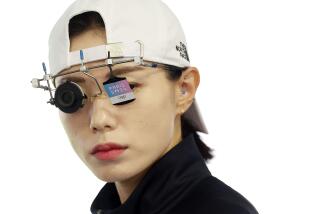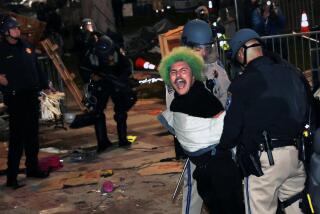After the Bullet Comes to Rest
- Share via
A gunshot is a small marvel of technical precision, a symmetrical projectile propelled through a machined tube by a scientifically formulated charge to attain a predetermined speed and spin. As soon as it encounters the human element, however, all precision tends to go out the window. Just ask trauma surgeon Christojohn Samuel.
At 9:30 on a weekday morning, Samuel is barely one-fourth of the way through his 12-hour shift at Providence Holy Cross Medical Center in Mission Hills. The day’s inevitable mayhem, brewing out there in gang-rich Pacoima and Arleta, has yet to descend on the hospital’s emergency department. No shouting squads of caregivers surround stunned victims on gurneys. No bloody footprints have accumulated on the speckled gray linoleum.
Sitting in a small room off of emergency registration, Samuel has time to answer pages, scribbling telephone numbers with a ballpoint pen on the left thigh of his mint-colored surgical scrubs. He has time, too, to talk about his work, much of which is performed at the messy intersection of gunshot and human corpus.
“Bullets are very unpredictable,” he says. “When you begin an operation, you want to get into the bullet’s path and try to go along and see what damage has been done.
“Sometimes you’re in there and you think you know where it went, but once inside the body, a bullet loses its velocity and can go here and there, zigzag, hit a bone and ricochet. It’s not so simple as a stab wound.”
In his six years as a trauma surgeon in the San Fernando Valley, the 48-year-old native of India has laid hands on hundreds of gunshot wounds. In the past 12 months, nearly 120 shot people have been through the emergency room of the mid-size hospital, one of two trauma centers in the Valley.
Plying his trade, Samuel has hefted the wholesale devastation to tissue wrought by close-range shotgun blasts. He has fingered the prim entry holes small-caliber bullets leave on the surface of human bodies and stitched order into the chaos they inflict within.
Infection is commonly an X-factor in gunshot wounds, he says. “Because of the speed with which it goes, the bullet is relatively sterile. Unfortunately, if it pierces through, say, bowel, it gets contaminated so it carries bacteria from that area to another. The other problem is, when the bodily tissues are damaged--either directly by the bullet or from the concussive forces that are distributed--they are more vulnerable to infection.”
The worst wounds are those to the lower abdomen, from navel to groin, and to the head. Large blood vessels in the former area can spill copiously, often sending patients into shock before they’ve reached the hospital. In the latter case, brain regions governing respiration and other vital functions often have been disabled, which is why so many of those victims are gone before they arrive.
*
Even head wounds, however, will surprise. “I had a week ago a 40-year-old man who’d denied a few guys a job after interviewing them, and the guys took a gun and shot this guy at close range in his head. So he comes in, he has this bullet wound, and we have no idea where the bullet is. So we do a CAT scan and the CAT scan shows that the bullet hit the thick skull bone and pushed the bone in and somehow must have ricocheted out. These bullets, 99% of the time, they go through. I was pleasantly surprised and pleased for this guy. I told him, ‘Hey, you’re a lucky man. God is with you.’ ”
Surgeons rarely remove bullets from victims’ bodies, unless they’ve lodged in areas such as blood vessels, from which they might migrate, or in joints. Stabilizing bleeding, fighting contamination, repairing tissue--these are the priorities.
Sometimes a bullet is even left in the brain because digging it out would cause as much damage as the bullet did.
Often patients are dismayed to learn that what invaded them has been left where it is. “They think, ‘Oh, the bullet is there, the stigma is there,’ ” the surgeon says.
When examining emergency patients, Samuel occasionally finds they’ve been shot before, sometimes more than once. “I recently had a very crazy guy who was brought in on Thanksgiving Day with a stab wound to the left side of the heart,” he says. “When we did the X-ray, we found bullets all over. With gang members, it’s like a disease--a disease that recurs sometimes. And our trauma system is so good, it resuscitates these people, so they haunt us again.”
The work, Samuel says, is “challenging, but most of the time not gratifying.” When surgeons treat gunshot wounds, they’re trafficking in the stuff of tragedy--attempted murder, attempted suicide, the 10-year-old who found his dad’s revolver.
It’s not like dealing with a factory worker who had an arm mangled in a machine. “At least there’s something of the true accident to that,” Samuel says. “But this is usually deliberate infliction. And it’s so brutal. I can’t think of anything comparable--I’ve got a 13-year-old boy upstairs shot in both sides of the head, and now on a respirator. It’s gruesome.”
Last week Los Angeles County Supervisor Zev Yaroslavsky, who represents much of the Valley and the Westside, made news when he called for a ban on cheap handguns and prohibiting licensed gun dealers from selling their wares in residential areas of the county. Maybe it will reduce the number of shooting victims locally, but probably not.
*
In any case, to say guns are in the news is to say that oxygen is in the air. No day’s newspaper or news broadcast is without news about guns. Guns are as much a staple of the news industry as of the gun industry.
The reason is simple: Death and near-death are the ultimate subjects of interest to living people. And in America, guns bring death in fabulous volume and with astonishing ease. Shooting a person requires neither strength nor physical courage.
Just a crooking of the index finger, and Christojohn Samuel and colleagues are in for another busy day.
More to Read
Sign up for Essential California
The most important California stories and recommendations in your inbox every morning.
You may occasionally receive promotional content from the Los Angeles Times.










